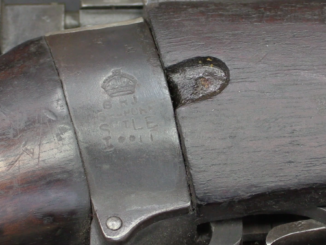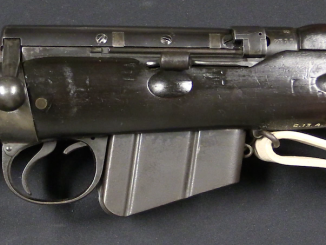How does one keep a flintlock action reliable in wet, riany weather? Well, let’s have a look at a flintlock shotgun designed specifically to be waterproof! This is a Joseph Manton shotgun from about 1815. Manton was not the only smith making this sort of waterproof action, but his is a fine example…
Related Articles

Handgun
Lancaster Howdah Pistols at RIA
Charles Lancaster was a master London gunsmith who made 2-barrel and 4-barrel pistols in a variety of British revolver cartridges (commonly known as Howdah pistols). Many of his pistols was purchased privately by British military […]

Bolt Action Rifles
Ishapore SMLE MkI** India Pattern (Video)
While many people are familiar with the Ishapore 2A1 rifles chambered in 7.62mm NATO (largely thanks to their importation and sale in the US in large numbers), production of Indian Enfield rifles actually dates back […]

Bolt Action Rifles
Lee Metford MkI: Great Britain’s First Magazine Rifle
The British went into the 1880s with plans to adopt the Enfield-Martini as its new rifle, a single shot Martini-action rifle with essentially a sidesaddle of ready-access cartridges on the side of the receiver. It […]

What does the safety accomplish that a simple standard half-cock notch doesn’t?
Just guessing: safe-cock on that piece appears to be pretty close to full cock. The safety thus provides visible indication of being in safe vs. full, in addition to just providing visual indication of safe.
But we’d have to check the operator’s manual, if any PDFs survive.
“But we’d have to check the operator’s manual, if any PDFs survive.” – LOL
I’d think an engraved pointer would be a simple way to accomplish that with at least four fewer parts.
Pretty much the whole lock mechanism is on the outside. So is the safety catch.
I’m pretty sure the triggers, sears, and tumblers are inside / between the lockplates, exactly like most other flintlocks.
This is an old timey gun. The manual would have been on a CD.
It provides just one more measure of safety in an inherently-dangerous machine. Single-action mechanisms have very fragile sear noses because they must be small, sharp, and very hard to provide a crisp trigger pull. As the sear nose is what sits in the half-cock notch, which is also fairly shallow, it is prone to breaking and allowing the cock to fall. The sear can also simply bounce out of its notch if the gun is dropped or jarred. This is, for example, why original Colt single-action revolvers cannot be safely carried with a full cylinder and the hammer at half cock; Doing so is asking for a leg full of bullet.
All things considered, this is a much stronger ‘safety’ than any half-cock position would be.
It ought to be mentioned that Joseph Manton the gunsmith was held in such high renown that his products have made it into the high seas novels of Patrick O’Brien. Myatt’s and Hogg’s coffee-table books on gun history feature examples of his fine dueling pistols. Nowadays, surviving examples of Manton’s work fetch remarkable prices at auctions. He went bankrupt in legal battles with the British army over a new kind of artillery shell and died in 1835. Among his employees were Greener, Purdey, and Lancaster, all of whom founded their own innovative gunsmithing firms.
Do you remember which book? Did Maturin own one?
I believe Maturin owned a Manton fowling piece (shotgun). Manton pistols and shotguns tend to show up in the later O’Brien novels. It’s hard to pinpoint one novel since Manton guns are just mentioned as a fact of life, like Glocks in 21st century America.
In “The Fortune of War” Aubrey’s American “host” loans him one or a pair of Manton pistols during his time as a prisoner in Boston. As Mr. Lewis below mentions, they get mentioned in the later books frequently, as if there were no other gunmakers. The maker’s name is always mentioned as a signifier of quality.
“(…)went bankrupt in legal battles with the British army over a new kind of artillery shell(…)”
Gunnery in 1858: Being a Treatise on Rifles, Cannon, and Sporting Arms by Greener available here http://gutenberg.org/ebooks/43799
The late Joseph Manton has the merit of being the first modern inventor of rifled cannon. His idea was, that if a motion on an axis parallel to the horizon could be given to cannon balls, they would range farther and with greater accuracy. As there exists great difficulty in causing the rifling in a gun to act upon an iron ball, he constructed a cup of wood, into which the ball was fitted, projections being made upon the wood to fit into the groves of the rifle; the spinning motion thus being communicated to the ball by its wooden adjunct. The result was twofold; for the expansions of the wood during the explosion, filled the tube of the gun tight, and effectually destroyed the windage. The government of the day did offer him a premium of one farthing each; but “Joe” over-reached himself, asking the sum of £30,000 down; this was refused, and the patent was allowed to expire without the Government taking any advantage of it, and experiments ceased to be made in this direction.
as for Manton’s works in hand-held fire-arms
Joseph Manton is entitled to the gratitude, not only of the present generation of gun-makers, but of all succeeding ones, for this reason,—he not only gave a character to English guns, but so linked his name with improvements, that it will never be forgotten. His was the mind to know and appreciate the value of good workmanship; he elevated the English artisan with himself, and raised the gunmaker to the acme of mechanical skill: for, without invidious comparison of the ability required in other professions, we may say that a first-rate workman as a gun-maker (I mean only a gun-maker) is one of the very best mechanics England can boast of, or in truth any part of the world. Gun-making is the profession of a man of mind: any man or any workman cannot make a gun, working by square and rule entirely, as other mechanics do: no, the true gun-maker is an artist, and Joe Manton made him so.
where Barrel welders, borers, lock-filers, &c., are not technically gun-makers: the latter are those workmen who, having barrels, locks, wood for stock, &c., make them into a gun. It has been customary to say gunsmiths; but this appellation can be applied to the worker in iron only.
Also even in back 1858 his guns were apparently so sought after to lead to numerous knock-offs:
Manton’s guns have become like pictures of celebrated masters; had he produced one per hour during his existence, he could not have made one-half of the number that bear his name.
Back in the 70’s, I used to hunt exclusively with flintlocks and I owned a couple of”waterproof “ locks. They were a bit better than standard locks in misty weather but not by much. The workmanship on that Manton is extraordinary. It would be nice to be able to test it but I doubt if anybody would be willing to fire it, let alone getting it wet…
Great video.
I remember hill walking in the Lake District in 1980’s when we were digging in Carlisle. I very much doubt that even a percussion cap would have survived those downpours that went on for weeks
True enough, the powder would get wet just from the moisture in the air. But this shotgun has a gutter system! which is really nifty, if of dubious practical value. In turn this necessitates a rain test for science!
The gunsmitch should have added a gargoyle at the exit point for the water on the bottom. 😉
The original user of this gun would NEVER have said it was for hunting.
Hunting is chasing a mammal quarry with scent hounds.
Shooting is using a shot gun on flying birds.
Stalking is using a rifle on a mammal quarry.
You might be interested in: Waterproofing your flintlock [https://capandball.com/waterproofing-your-flintlock/].
It looks like a sophisticated H. Nock system.
https://en.wikipedia.org/wiki/Henry_Nock
https://www.cowanauctions.com/lot/h-nock-british-military-screwless-musket-or-carbine-lock-3266607
If he “invented” the cannon shell in the same way, then it is not surprising that he went bankrupt. LOL
Jack Aubrey owned a Manton fowling piece with a waterproof lock and a platinum flash-hole, which excited comment from Maturin that “he was a wealthy man, but never so wealthy as to warrant a platinum touch-hole for his gun.” The rifle which Maturin uses to kill Andrew Wray and Edward Ledward is also a Manton, later given in payment for a Chinese trader’s rescue of his shipwrecked crewmates after a ferocious attack my Indonesian Dayak pirates. I believe but cannot offhand recall that a Manton pistol later figures in Clarissa Oakes’s defense of Maturin’s daughter. The occasional presence of Joe Manton’s masterworks is one of the details which make the Aubreyad my favourite books.
Fine piece, he he.